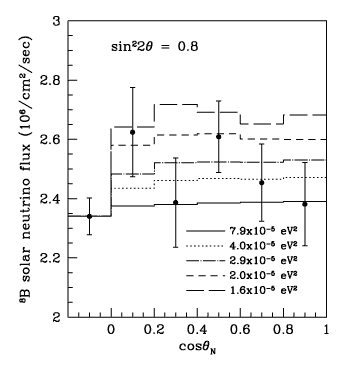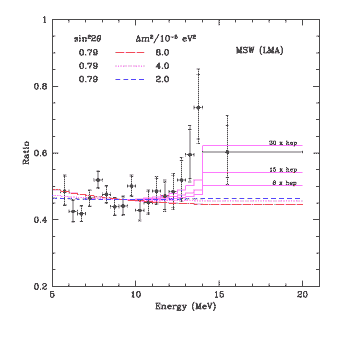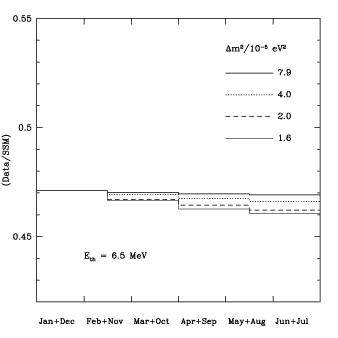 Predicted versus the observed zenith angle dependence of the total
event rate above 6.5 MeV.
Here cos
Predicted versus the observed zenith angle dependence of the total
event rate above 6.5 MeV.
Here cos  N
= cos(
N
= cos( -
-  ), where
), where  N is the
nadir angle and
N is the
nadir angle and  is the zenith angle. The first bin is the
average of the daytime rate of all of the observations.
The figure shows
the dependence of the
is the zenith angle. The first bin is the
average of the daytime rate of all of the observations.
The figure shows
the dependence of the  -e scattering
rate in the SuperKamiokande detector upon the nadir angle of
the sun at the time of the observation is shown for a representative
range of
-e scattering
rate in the SuperKamiokande detector upon the nadir angle of
the sun at the time of the observation is shown for a representative
range of  m2 and fixed sin2 2
m2 and fixed sin2 2 . The results are
averaged over an entire year.
The data are from SuperKamiokande hep-ex/9903034.
The LMA solution predicts a zenith angle dependence that is
observed as a approximately 2
. The results are
averaged over an entire year.
The data are from SuperKamiokande hep-ex/9903034.
The LMA solution predicts a zenith angle dependence that is
observed as a approximately 2 Day-Night effect by SuperKamiokande. In
addition, the LMA predicts that the difference between Day-Night is
approximately independent of what time at night the observations are made.
This flat zenith angle dependence is consistent with the observations and is
not predicted by all SMA solutions.
Day-Night effect by SuperKamiokande. In
addition, the LMA predicts that the difference between Day-Night is
approximately independent of what time at night the observations are made.
This flat zenith angle dependence is consistent with the observations and is
not predicted by all SMA solutions.
 Distortion of the 8B electron recoil energy spectrum.
The figure
shows the ratio, R, of
the measured number of electrons to the number expected on the basis of
the standard models.
Solutions are shown with the standard model fluxes of 8B and
hep neutrinos (the approximately horizontal lines)
and with the standard hep flux multiplied
by factors of 8, 15,
and 30 (ratio increases at highest energies).
The calculated ratios are shown for three
different values of
Distortion of the 8B electron recoil energy spectrum.
The figure
shows the ratio, R, of
the measured number of electrons to the number expected on the basis of
the standard models.
Solutions are shown with the standard model fluxes of 8B and
hep neutrinos (the approximately horizontal lines)
and with the standard hep flux multiplied
by factors of 8, 15,
and 30 (ratio increases at highest energies).
The calculated ratios are shown for three
different values of  m2 and
with sin2 2
m2 and
with sin2 2 = 0.79
in order to illustrate the range of
behaviors that result from choosing neutrino parameters.
Results similar to this viewgraph are obtained if
sin2 2
= 0.79
in order to illustrate the range of
behaviors that result from choosing neutrino parameters.
Results similar to this viewgraph are obtained if
sin2 2 is allowed to vary over
a representative range of the allowed global LMA solutions that are
consistent with the average measured event rates.
The experimental points show the SuperKamiokande results for 708 days of
observations. The bottom line is that the observed spectrum is
consistent with the standard model and the LMA predictions below about
13.5 MeV. Above 13.5 MeV, there is some indication of a larger
counting rate. On the LMA hypothesis, this must be accounted for by
contamination by a large hep contribution or by systematic or
statistical uncertainties in the experimental data.
is allowed to vary over
a representative range of the allowed global LMA solutions that are
consistent with the average measured event rates.
The experimental points show the SuperKamiokande results for 708 days of
observations. The bottom line is that the observed spectrum is
consistent with the standard model and the LMA predictions below about
13.5 MeV. Above 13.5 MeV, there is some indication of a larger
counting rate. On the LMA hypothesis, this must be accounted for by
contamination by a large hep contribution or by systematic or
statistical uncertainties in the experimental data.
 The predicted seasonal dependence of the total
event rate with eccentricity removed.
The dependence of the
The predicted seasonal dependence of the total
event rate with eccentricity removed.
The dependence of the  -e scattering
rate in the SuperKamiokande detector upon the season of the year
is shown for a representative
range of LMA solutions with variable
-e scattering
rate in the SuperKamiokande detector upon the season of the year
is shown for a representative
range of LMA solutions with variable  m2 and
sin2 2
m2 and
sin2 2 = 0.8.
In order to isolate the seasonal effect of neutrino oscillations, the
effect of the eccentricity of the earth's orbit has been removed.
The viewgraph refers to all events above 6.5 MeV. Very little
seasonal dependence (beyond that implied by the eccentricity of the earth's
orbit) is predicted by the LMA. This prediction is consistent with the
observations but the current error bars are huge on this scale, approximately
± 0.02.
= 0.8.
In order to isolate the seasonal effect of neutrino oscillations, the
effect of the eccentricity of the earth's orbit has been removed.
The viewgraph refers to all events above 6.5 MeV. Very little
seasonal dependence (beyond that implied by the eccentricity of the earth's
orbit) is predicted by the LMA. This prediction is consistent with the
observations but the current error bars are huge on this scale, approximately
± 0.02.
 Back to John Bahcall's
Neutrino Viewgraphs
Back to John Bahcall's
Neutrino Viewgraphs
Address questions and comments about this server to webmaster@sns.ias.edu